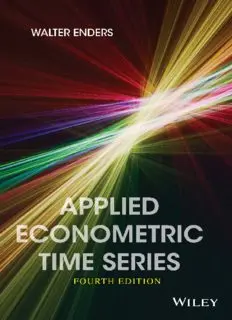
Applied Econometric Time Series PDF
Preview Applied Econometric Time Series
TrimSize:6inx9in Enders bindex.tex V1-08/27/2014 6:48pm Page486 TrimSize:6inx9in Enders ffirs.tex V1-08/21/2014 11:43am Pagei FOURTHEDITION APPLIED ECONOMETRIC TIME SERIES WALTER ENDERS UniversityofAlabama TrimSize:6inx9in Enders ffirs.tex V1-09/02/2014 12:46pm Pageii VicePresidentandExecutivePublisher GeorgeHoffman ExecutiveEditor JoelHollenbeck SponsoringEditor MarianProvenzano ProjectEditor BrianBaker EditorialAssistant JacquelineHughes PhotoEditor BillyRay CoverDesigner KenjiNgieng AssociateProductionManager JoycePoh SeniorProductionEditor JoleneLing ProductionManagementServices Laserwords CoverImageCredit Mmdi/Stone/GettyImages Thisbookwassetin10/12TimesbyLaserwordsandprintedandboundbyLightningSource. Foundedin1807,JohnWiley&Sons,Inc.hasbeenavaluedsourceofknowledgeandunderstandingfor morethan200years,helpingpeoplearoundtheworldmeettheirneedsandfulfilltheiraspirations.Our companyisbuiltonafoundationofprinciplesthatincluderesponsibilitytothecommunitiesweserveand whereweliveandwork.In2008,welaunchedaCorporateCitizenshipInitiative,aglobalefforttoaddress theenvironmental,social,economic,andethicalchallengeswefaceinourbusiness.Amongtheissueswe areaddressingarecarbonimpact,paperspecificationsandprocurement,ethicalconductwithinour businessandamongourvendors,andcommunityandcharitablesupport.Formoreinformation,pleasevisit ourwebsite:www.wiley.com/go/citizenship. Copyright©2015,2010,2009,1998JohnWiley&Sons,Inc.Allrightsreserved.Nopartofthis publicationmaybereproduced,storedinaretrievalsystem,ortransmittedinanyformorbyanymeans, electronic,mechanical,photocopying,recording,scanningorotherwise,exceptaspermittedunderSections 107or108ofthe1976UnitedStatesCopyrightAct,withouteitherthepriorwrittenpermissionofthe Publisher,orauthorizationthroughpaymentoftheappropriateper-copyfeetotheCopyrightClearance Center,Inc.,222RosewoodDrive,Danvers,MA01923(Website:www.copyright.com).Requeststothe PublisherforpermissionshouldbeaddressedtothePermissionsDepartment,JohnWiley&Sons,Inc.,111 RiverStreet,Hoboken,NJ07030-5774,(201)748-6011,fax(201)748-6008,oronlineat: www.wiley.com/go/permissions. Evaluationcopiesareprovidedtoqualifiedacademicsandprofessionalsforreviewpurposesonly,foruse intheircoursesduringthenextacademicyear.Thesecopiesarelicensedandmaynotbesoldortransferred toathirdparty.Uponcompletionofthereviewperiod,pleasereturntheevaluationcopytoWiley.Return instructionsandafreeofchargereturnshippinglabelareavailableat:www.wiley.com/go/returnlabel.If youhavechosentoadoptthistextbookforuseinyourcourse,pleaseacceptthisbookasyour complimentarydeskcopy.OutsideoftheUnitedStates,pleasecontactyourlocalsalesrepresentative. LibraryofCongressCataloging-in-PublicationData Enders,Walter,1948- Appliedeconometrictimeseries/Walter,UniversityofAlabama.–Fourthedition. pagescm Includesindex. ISBN978-1-118-80856-6(pbk.) 1. Econometrics.2. Time-seriesanalysis.I.Title. HB139.E552015 330.01’519233–dc23 2014013428 PrintedintheUnitedStatesofAmerica 10 9 8 7 6 5 4 3 2 1 TrimSize:6inx9in Enders ffirs.tex V1-08/21/2014 11:43am Pageiii ToLola TrimSize:6inx9in Enders ftoc.tex V1-08/21/2014 11:47am Pageiv CONTENTS PREFACE vii ABOUTTHEAUTHOR x CHAPTER1 DIFFERENCEEQUATIONS 1 Introduction 1 1 Time-SeriesModels 1 2 DifferenceEquationsandTheirSolutions 7 3 SolutionbyIteration 10 4 AnAlternativeSolutionMethodology 14 5 TheCobwebModel 18 6 SolvingHomogeneousDifferenceEquations 22 7 ParticularSolutionsforDeterministicProcesses 31 8 TheMethodofUndeterminedCoefficients 34 9 LagOperators 40 10 Summary 43 QuestionsandExercises 44 CHAPTER2 STATIONARYTIME-SERIESMODELS 47 1 StochasticDifferenceEquationModels 47 2 ARMAModels 50 3 Stationarity 51 4 StationarityRestrictionsforanARMA(p,q)Model 55 5 TheAutocorrelationFunction 60 6 ThePartialAutocorrelationFunction 64 7 SampleAutocorrelationsofStationarySeries 67 8 Box–JenkinsModelSelection 76 9 PropertiesofForecasts 79 10 AModeloftheInterestRateSpread 88 11 Seasonality 96 12 ParameterInstabilityandStructuralChange 102 13 CombiningForecasts 109 14 SummaryandConclusions 112 QuestionsandExercises 113 iv TrimSize:6inx9in Enders ftoc.tex V1-08/21/2014 11:47am Pagev CONTENTS v CHAPTER3 MODELINGVOLATILITY 118 1 EconomicTimeSeries:TheStylizedFacts 118 2 ARCHandGARCHProcesses 123 3 ARCHandGARCHEstimatesofInflation 130 4 ThreeExamplesofGARCHModels 134 5 AGARCHModelofRisk 141 6 TheARCH-MModel 143 7 AdditionalPropertiesofGARCHProcesses 146 8 MaximumLikelihoodEstimationofGARCHModels 152 9 OtherModelsofConditionalVariance 154 10 EstimatingtheNYSEU.S.100Index 158 11 MultivariateGARCH 165 12 VolatilityImpulseResponses 172 13 SummaryandConclusions 174 QuestionsandExercises 176 CHAPTER4 MODELSWITHTREND 181 1 DeterministicandStochasticTrends 181 2 RemovingtheTrend 189 3 UnitRootsandRegressionResiduals 195 4 TheMonteCarloMethod 200 5 Dickey–FullerTests 206 6 ExamplesoftheDickey–FullerTest 210 7 ExtensionsoftheDickey–FullerTest 215 8 StructuralChange 227 9 PowerandtheDeterministicRegressors 235 10 TestswithMorePower 238 11 PanelUnitRootTests 243 12 TrendsandUnivariateDecompositions 247 13 SummaryandConclusions 254 QuestionsandExercises 255 CHAPTER5 MULTIEQUATIONTIME-SERIESMODELS 259 1 InterventionAnalysis 261 2 ADLsandTransferFunctions 267 3 AnADLofTerrorisminItaly 277 4 LimitstoStructuralMultivariateEstimation 281 5 IntroductiontoVARAnalysis 285 6 EstimationandIdentification 290 7 TheImpulseResponseFunction 294 8 TestingHypotheses 303 9 ExampleofaSimpleVAR:DomesticandTransnationalTerrorism 309 10 StructuralVARs 313 11 ExamplesofStructuralDecompositions 317 12 OveridentifiedSystems 321 TrimSize:6inx9in Enders ftoc.tex V1-08/21/2014 11:47am Pagevi vi CONTENTS 13 TheBlanchard–QuahDecomposition 325 14 DecomposingRealandNominalExchangeRates:AnExample 331 15 SummaryandConclusions 335 QuestionsandExercises 337 CHAPTER6 COINTEGRATIONANDERROR-CORRECTIONMODELS 343 1 LinearCombinationsofIntegratedVariables 344 2 CointegrationandCommonTrends 351 3 CointegrationandErrorCorrection 353 4 TestingforCointegration:TheEngle–GrangerMethodology 360 5 IllustratingtheEngle–GrangerMethodology 364 6 CointegrationandPurchasingPowerParity 370 7 CharacteristicRoots,Rank,andCointegration 373 8 HypothesisTesting 380 9 IllustratingtheJohansenMethodology 389 10 Error-CorrectionandADLTests 393 11 ComparingtheThreeMethods 397 12 SummaryandConclusions 400 QuestionsandExercises 401 CHAPTER7 NONLINEARMODELSANDBREAKS 407 1 LinearVersusNonlinearAdjustment 408 2 SimpleExtensionsoftheARMAModel 410 3 TestingforNonlinearity 413 4 ThresholdAutoregressiveModels 420 5 ExtensionsoftheTARModel 427 6 ThreeThresholdModels 433 7 SmoothTransitionModels 439 8 OtherRegimeSwitchingModels 445 9 EstimatesofSTARModels 449 10 GeneralizedImpulseResponsesandForecasting 453 11 UnitRootsandNonlinearity 461 12 MoreonEndogenousStructuralBreaks 466 13 SummaryandConclusions 474 QuestionsandExercises 475 INDEX 479 REFERENCES(ONLINE) ENDNOTES(ONLINE) STATISTICALTABLES(ONLINE) TrimSize:6inx9in Enders fpref.tex V2-08/18/2014 6:29pm Pagevii PREFACE When I began writing the first edition, my intent was to write a text in time-series macroeconometrics.Fortunately,anumberofmycolleaguesconvincedmetobroaden the focus. Applied microeconomists have embraced time-series methods, and the politicalsciencejournalshavebecomemorequantitative.Asinthepreviouseditions, examples are drawn from macroeconomics, agricultural economics, international finance, and my work with Todd Sandler on the study of domestic and transnational terrorism.Youshouldfindthattheexamplesinthetextprovideareasonablebalance betweenmacroeconomicandmicroeconomicapplications. 1. BACKGROUND Thetextisintendedforthosewithsomebackgroundinmultipleregressionanalysis. Ipresumethereaderunderstandstheassumptionsunderlyingtheuseofordinaryleast squares.Allofmystudentsarefamiliarwiththeconceptscorrelationandcovariation; theyalsoknowhowtouset-testsandF-testsinaregressionframework.Iusetermssuch asmeansquareerror,significancelevel,andunbiasedestimatewithoutexplainingtheir meaning. Twochaptersofthetextexaminemultipletime-seriestechniques.Towork through these chapters, it is necessary to know how to solve a system of equations using matrix algebra. Chapter 1, entitled “Difference Equations,” is the cornerstone of the text. In my experience, this material and a knowledge of regression analysis aresufficienttobringstudentstothepointwheretheyareabletoreadtheprofessional journalsandtoembarkonaseriousappliedstudy.Nevertheless,oneunfortunatereader wrote,“Idideverythingyousaidinyoubook,andmyarticlestillgotrejected.” Some of the techniques illustrated in the text need to be explicitly programmed. StructuralVARsneedtobeestimatedusingapackagethathasthecapacitytomanip- ulate matrices. Monte Carlo methods are very computer intensive. Nonlinear models needtobeestimatedusingapackagethatcanperformnonlinearleastsquaresandmax- imumlikelihoodestimation.Completelymenu-drivensoftwarepackagesarenotable toestimateeveryformoftime-seriesmodel.AsItellmystudents,bythetimeapro- cedureappearsonthemenuofaneconometricsoftwarepackage,itisnotnew.Toget themostfromthetext,youshouldhaveaccesstoaprogramsuchasEViews,RATS, MATLAB,R,STATA,SAS,orGAUSS. I take the term applied that appears in the title earnestly. Toward this end, I believe in teaching by induction. The method is to take a simple example and buildtowardmoregeneralandmorecomplicatedmodels.Detailedexamplesofeach procedure are provided. Each concludes with a step-by-step summary of the stages typicallyemployedinusingthatprocedure.Theapproachisoneoflearningbydoing. vii TrimSize:6inx9in Enders fpref.tex V2-08/18/2014 6:29pm Pageviii viii PREFACE A large number of solved problems are included in the body of each chapter. The “Questions and Exercises” section at the end of each chapter is especially important.Youareencouragedtoworkthroughasmanyoftheexamplesandexercises aspossible. 2. WHAT IS NEW IN THE FOURTH EDITION? Ihave triedtobecarefulabout thetrade-offbetween beingcompleteandbeingcon- cise. In deciding on which new topics to include in the text, I relied heavily on the e-mailmessagesIreceivedfrominstructorsandfromstudents.Tokeepthemanuscript from becoming encyclopedic, I have included a number of new topics in the Sup- plementary Manual. The new material in Chapter 2 discusses the important issue of combining multiple univariate forecasts so as to reduce overall forecast error vari- ance.Chapter3expandsthediscussionofmultivariateGARCHmodelsbyillustrating volatilityimpulseresponsefunctions.Indoingso,volatilityspilloversneedtobeana- lyzed in a way that is analogous to the impulse responses from a VAR. I received a surprisinglylargenumberofquestionsregardingautoregressivedistributedlag(ADL) models.Assuch,thefirstfewpartsofChapter5havebeenrewrittensoastoshowthe appropriatewaystoproperlyidentifyandestimateADLs.Thisnewmaterialcomple- mentsthematerialinChapter 6involvingADLsinacointegrated system.Chapter 7 nowdiscussestheso-calledDaviesprobleminvolvingunidentifiednuisanceparame- tersunderthenullhypothesis.Thechaptercontinuestodiscusstheissuesinvolvedwith testingformultipleendogenousbreaks(i.e.,potentialbreaksoccurringatanunknown date)usingtheBai–Perronprocedure.Moreover,sincebreakscanmanifestthemselves slowly,theprocessofestimatingamodelwithalogisticbreakisillustrated. SomecontenthasbeenmovedtothewebsitefortheFourthEdition.Thiscontent is called out in the Table of Contents as being “online.” To locate this content, go to Wiley.com/College/Endersortotime-series.net. 3. ADDITIONAL MATERIALS Sinceitwasnecessarytoexcludesometopicsfromthetext,IpreparedaSupplementary Manualtothetext.ThismanualcontainsmaterialthatIdeemedimportant(orinterest- ing),butnotsufficientlyimportantforallreaders,toincludeinthetext.Oftenthetext refersyoutothisSupplementaryManualtoobtainadditionalinformationonatopic. Toassistyouinyourprogramming,IhavewrittenaRATSProgrammingManual toaccompanythistext.Ofcourse,itisimpossibleformetohaveversionsoftheguide foreverypossibleplatform.Mostprogrammersshouldbeabletotranscribeaprogram writteninRATSintothelanguageusedbytheirpersonalsoftwarepackage. An Instructors’ Manual is available to those adopting the text for their class. Themanualcontainstheanswerstoallofthemathematicalquestions.Italsocontains programs that can be used to reproduce most of the results reported in the text and allofthemodelsindicatedinthe“QuestionsandExercises”sections.Versionsofthe manualareavailableforEVIEWS,RATS,SAS,andSTATAusers.
